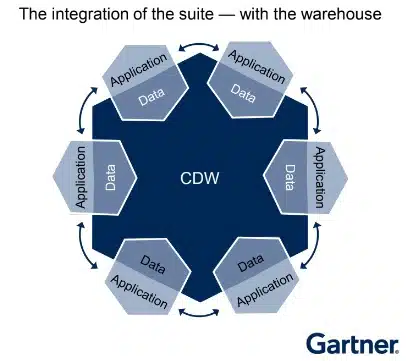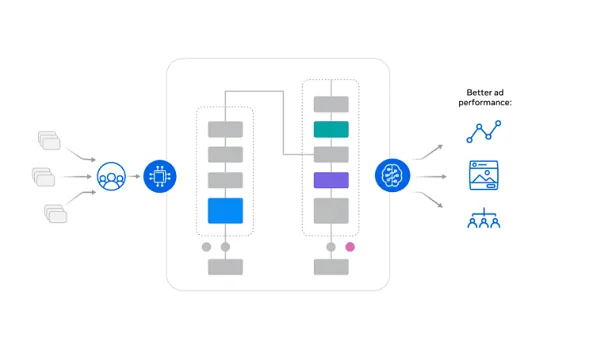The growing use of cloud data warehouses by premium brands will challenge how we think about martech stacks. It goes beyond the composable CDP and the composable customer engagement platform. It calls for a radical rethinking of the relationship between applications and data.
That was the challenging, but also compelling, message delivered by Ben Bloom, Gartner VP, analyst, in his session at the Gartner Symposium this week.
The way we are
The martech stack has been failing marketers, whether it be (primarily) an integrated suite or a collection of point solutions circuiting a central hub. Utilization of martech tools has fallen from 58% in 2020 to 33% in 2023 (all research quoted here is from Gartner).
“The teams that chose the best-of-breed approach and the teams that chose more of an integrated suite approach did not have different results when it came to their levels of marketing technology utilization,” Bloom told us. “
Enter the cloud data warehouse
AWS, Google Big Query, Snowflake; the cloud data warehouse (CDW) is not a new technology. It has typically been a repository for any brand data, not just customer data, and has been the purview of IT. What is new is the sudden and dramatic impact it is having on marketing — to the extent that marketing teams must be prepared to be actively involved in CDW purchase decisions.
What this signals, said Bloom, is a movement away from an app eco-system to a data eco-system. Thus far, many apps have been standalone elements in the stack, hopefully integrating with other apps. “So you buy some multichannel marketing solution,” Bloom explained. “You can put data into it, manage those audiences, send out email messages to your contacts and you get some reporting as a result.”
This model creates enormous risk, Bloom continued. “You don’t just have one data store; you’ve got data in every one of these applications. From the perspective of how much data is now at risk of being copied, replicated, or ungoverned across these applications. The customer data platform was supposed to be the savior but it may make the problem worse. It’s not neutral territory because the data capabilities of most CDP bundles are really designed around the use cases of marketers. If there are functions outside of marketing that need that data, that kind of marketing-specific solution is less appealing.”
Unbundling apps and data


Using a CDW creates the possibility of “unbundling” the app, “where we do the work,” said Bloom, and the data.
The applications, in other words — be they marketing automation tools, CDPs, customer engagement platforms, DXPs, etc. — reach down into the CDW for the data they need for specific tasks. There are many ways of doing that; Bloom emphasized repeatedly that it’s okay to copy data, for example; people have been doing that for years.
Sixty-six percent of CDW adopters report that they have the following solutions in their stack, sitting atop the warehouse:
- Customer data platform.
- Data clean room.
- Identity resolution.
- Multichannel marketing hub.
- Personalization engine.
- Web and digital experience analytics.
In some ways, these are the familiar elements of a marketing stack assembled differently (contrast the “stack” pictured above with a typical stack representation). As more apps become essentially warehouse-native, apps without connectivity to the warehouse become targets for consolidation or redundancy, potentially reducing the under-utilization problem.
“Genius” or “gifted brands (the two top echelons in Gartner’s Digital IQ index) are most likely to store data in a CDW. Interestingly, they’re also more likely than less smart brands to have both a CDW and a CDP. “Many organizations are stuck in a war over which approach and that misses an opportunity because most marketing teams are not going to want to spend a lot of time in that warehouse directly. You are very likely going to need both or some of the components of both.” The CDP, of course, would be connected to the CDW.
Remember the 360-degree view?
These reflections seem consistent with the skepticism about the need for a 360-degree view of the customer expressed at last year’s Symposium. This model rejects pushing all available customer data into some marketing stack hub.
“It could be that there are data sets you need, say for advertising,” Bloom agreed, “or matching cookie data to an onboarding or identity provider. That data doesn’t need to live in the CDP. What we’re hearing from clients is that they have to think about their warehouse potentially enabling some of that activation almost in parallel with other parts of their ecosystem. I’m no fan of the 360-degree view concept because I think it’s so costly and potentially leads marketing teams down the wrong path. But it could also be that the experience you’re trying to enable for advertising, say, might be so different that you shouldn’t try to combine it all and say there’s an all-encompassing data set we’re going to place in one [application].”
Roadmap recommendations from Gartner:
- Identify the owners of cloud-based data warehouse capabilities within your enterprise data stack and embed marketing capability owners in their decision-making processes.
- Audit your data use cases for cross-functional dependence to align your martech stack to the future state of enterprise data.
- Cull martech vendors, especially those with poor warehouse integration features or roadmaps, to strategically consolidate for the future.
- Accept and embrace data duplication where realistically necessary to power personalization and decisions at the edge.






































![Spider-Man Is Back in Black With the Green Goblin in New Funko Pop! Figures [Exclusive] Spider-Man Is Back in Black With the Green Goblin in New Funko Pop! Figures [Exclusive]](https://static1.colliderimages.com/wordpress/wp-content/uploads/2025/03/spider-man-the-animated-series-green-goblin.jpg)



































